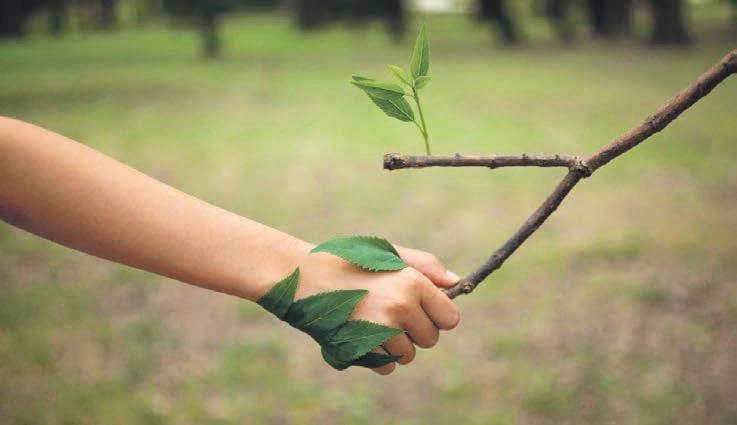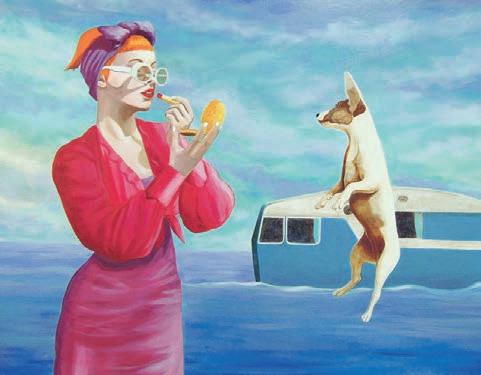
4 minute read
Extra
Wonders surround gallery staff
One of the wonderful things about working in a museum and gallery is being surrounded by beautiful, intriguing, and thought-provoking works of art.
Knowing how an artist got to the fi nal piece through the backstory is completely fascinating.
Take Jo Torr’s sculpture exhibition Te Hono Wai, Where Waters Meet. It is a stunning collection of sculptures highlighting encounters between Māori and Europeans before the signing of the Treaty of Waitangi.
He Tūtakitaki is about an encounter consisting of two parts; a kaitaka woven in muka that references 18th century cloaks, and a found embroidered silk shawl with the kite imagery drawn by Tītere.
While in England Tuai and Tītere were known to have performed ‘native dance’ in ‘native dress’ while staying in the homes of their patrons. The viewer is encouraged to consider the consequences of an incidence where “a lady, beautiful and accomplished” became hopelessly infatuated with Tītere and entered his bedroom to declare her love for him.
In the exhibition A Year and More of Magical Thinking - New Work by Linda Tilyard, the artist fi nds inspiration for her work from all over the place. Her title painting “Lucy about to tow the caravan out while Tito wonders if ‘Candy Crush’ tastes nice” was created from an image of a caravan fl oating in Henley Lake a few years ago.
Linda said: “Lucy, a truck driver by profession, was on holiday when her husband plunged their caravan into Henley Lake. Waiting for her mates to turn up with a truck so she can tow it out, Lucy freshens her lipstick. Tito, the dog, is intrigued when he hears her say the colour is ‘Candy Crush’. Meanwhile husband Bob hides with a coff ee in Trocadero Café.”
Take time to have a closer look at these two items next time you visit Aratoi.
Te Hono Wai, Where Waters Meet is showing until September 5.
A Year and More of Magical Thinking - New Work by Linda Tilyard, is showing until September 26.

“Lucy about to tow the caravan out while Tito wonders if ‘Candy Crush’ tastes nice.” PHOTO/SUPPLIED
A CLIMATE FOR CHANGE
Nature-based solutions to tackle climate change
Melanie Barthe
I am the Climate Change Adviser for Carterton and South Wairarapa district councils. I am in charge of implementing the Ruamāhanga [Climate Change] Strategy for both councils. I also advise them in their transition to being more sustainable and educate our residents about climate change and sustainability.
Nature is our best ally to tackle climate change. Indeed, nature helps mitigate climate change by absorbing the carbon released by human activities.
Forests are probably the best-known carbon sink. But many other ecosystems also play a very important role in carbon sequestration. For example, did you know that the ocean absorbs around 25 per cent of all our carbon emissions and is the planet’s biggest carbon sink? The carbon sequestered in the ocean is called ‘blue carbon’.
Another signifi cant carbon sink is the soil. It is the second biggest sink after the ocean. Other ecosystems, such as wetlands and mangroves, are also important for storing carbon.
Many actions can be taken to increase the health of these ecosystems. Planting trees is probably one of the easiest. Regenerative farming and permaculture, which restore and preserve the soil, are also great solutions in our rural districts. Even on a small urban block, you can achieve many positive outcomes: you can create a small healthy and diverse ecosystem that will provide your household with nourishing food and absorb carbon.
Not only does nature help mitigate climate change, but it also helps us reduce the impacts of climate change.
Coastal ecosystems such as dunes and mangroves are great buff ers against sea level rise, providing shelter and protection. The damage to built environments will be much worse in areas with compromised coastal ecosystems than in places with well-preserved coastal ecosystems.
‘Green pockets’ help reduce the temperature in towns and cities. Therefore, the eff ects of heat waves can be reduced where more trees are planted. Another service rendered by these ‘green pockets’ is that they allow rainwater to infi ltrate the soil rather than running on the roads, thus reducing the risk of fl ooding.
Because climate change and conservation are so closely linked together, it made sense this year for Conservation Week in Wairarapa to have a focus on climate change. Local and national organisations are joining forces and working together – including Carterton, South Wairarapa and Masterton district councils, Greater Wellington Regional Council, the Department of Conservation, Pūkaha National Wildlife Centre, Wairarapa Pūkaha to Kawakawa, Enviroschools and Wairarapa Earth School.
Wairarapa residents will be able to celebrate Conservation Week with many diff erent events that will run from August 30 to September 15. You can see the full programme here: http://www.waip2k.org.nz/ conservation-week
Contact me at melanie@ cdc.govt.nz for more information.
‘Green pockets’ help reduce the temperature in towns and cities. PHOTO/SUPPLIED
A HOME FOR A PET
Hi, my name is Mabel. I am a sweet and playful, four-month-old, female puppy who will grow to be a medium to large mixed-breed dog. I need someone with lots of time to spend with me and train me. With some time, training and guidance, I will grow to be a lovely member of the family. If you and your home are ready for a puppy, and you think you can give me what I need, I would love to meet you. Please drop by and talk to the team at the Masterton SPCA during their opening hours, or call them on 0800 467 732.




